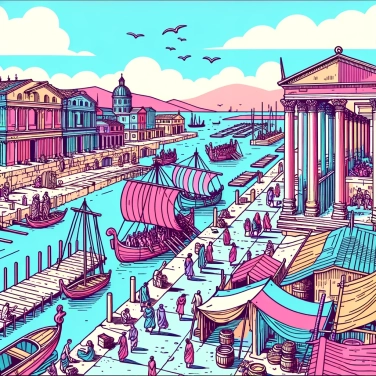Ostia Antica was the main port of Rome because it was strategically located at the mouth of the Tiber, offering easy access to maritime trade and ensuring the supply of essential goods and commodities to the city.

Ostia Antica was ideally located at the mouth of the Tiber, the main river that directly connected the city to Rome. This greatly facilitated travel, especially when it came to transporting all kinds of products or goods from the ships to the heart of the Roman Empire. Just about thirty kilometers from Rome, it was quick and convenient, especially at a time when long overland journeys were complicated, expensive, and quite tedious. In short, Ostia provided easy access to the sea and allowed Rome to effectively control what entered or left the territory. It's no wonder that this strategic spot quickly became essential for the entire Roman economy.
Ostia Antica was ideally located at the mouth of the Tiber, directly accessible from the Mediterranean Sea. Merchant ships arrived from all over, from Egypt, North Africa, Spain, and the Middle East, filled with grains, oil, wine, or precious fabrics. The city connected these international maritime trade routes directly to the center of Rome, facilitating the thriving trade of the capital. It was a true trading crossroads, with sailors, merchants, and goods from all origins constantly passing through. Essentially, everything Rome needed first passed through Ostia.
The port of Ostia Antica had an impressive network of docks and berths organized to accommodate many boats simultaneously. Thanks to its vast, well-structured warehouses, Ostia efficiently stored grains, oil, wine, and precious goods, thereby facilitating the rapid supply of Rome. Specially designed quays managed the immediate unloading of goods, which were then sorted and distributed according to their destination with remarkably precise logistics for the time. An ingenious supply system used the Tiber as a fast route connecting the port to Rome itself, allowing for the smooth and continuous transport of essential goods to the Roman capital. Everything was designed to avoid congestion – even back then, it was understood that smooth trade was essential!
Ostia Antica played a key role in the military security of Rome. Serving as a true forward post, the port provided constant surveillance of the coast and allowed for effective control of access to the capital. Thanks to its strategic position, the Roman authorities could quickly detect and repel potential attacks from the sea, particularly pirate raids or enemy incursions. Troops were stationed on-site to defend the coastline and intervene swiftly if necessary. The fortified installations also effectively protected the warehouses filled with precious goods destined for Rome, preventing their plunder. In short, Ostia was somewhat like the vigilant guardian that held the maritime gateway to Roman territory, ensuring peace and security for the capital of the Empire.
Ostia Antica was somewhat of an ideal city for trade. It quickly developed with many lively neighborhoods around the port, creating a dynamic commercial atmosphere. The warehouses (called horrea) allowed for the storage of a huge amount of goods, such as grain, oil, or spices, before being sent to Rome or elsewhere. The streets had a variety of shops: taverns, artisan boutiques, open-air markets, everything needed to attract merchants and customers. There were even buildings reserved for foreign communities, facilitating business and creating a nice cosmopolitan atmosphere for the time. This mix of commercial activities, craftsmanship, and housing made Ostia Antica a vibrant place where trade could take place easily and efficiently.
The mosaics found at Ostia Antica provide valuable information today about the trades practiced, commercial practices, and even the types of goods exchanged during the Roman era.
During peak times, the port of Ostia Antica employed 'navicularii', specialized merchants responsible for large-scale maritime and logistical exchanges.
Did you know? Ostia Antica allowed Rome to accommodate international-scale ships from the Mediterranean basin, particularly from Alexandria, bringing grains, spices, and thick rare fabrics.
At Ostia Antica, a highly efficient system of warehouses, called horrea, was already in use to store large quantities of grains, which were essential for supplying Rome.
Over time, the gradual silting and the decrease in the flow of the Tiber have limited its efficiency. To address these logistical issues, the Romans developed several other ports, such as Portus, built by Emperor Claudius nearby, thus becoming the main imperial maritime logistics center.
The port handled a wide variety of goods, including wheat from Egypt, olive oil from Hispania, wine from Gaul, spices and precious objects from the East, as well as slaves, ceramics, and various metals.
Ostia Antica had a comprehensive defensive system, including strong fortifications, a permanent military garrison, and a small naval fleet tasked with defending the entrance of the Tiber against any potential invaders.
Of course! The archaeological site of Ostia Antica is still open to the public. Visitors can explore the ruins of the warehouses, the theater, the public baths, and wander through the ancient cobbled streets.
Ostia Antica was located about 25 kilometers southwest of the center of Rome, which allowed for a direct and swift connection via land and river (through the Tiber).

No one has answered this quiz yet, be the first!' :-)
Question 1/5